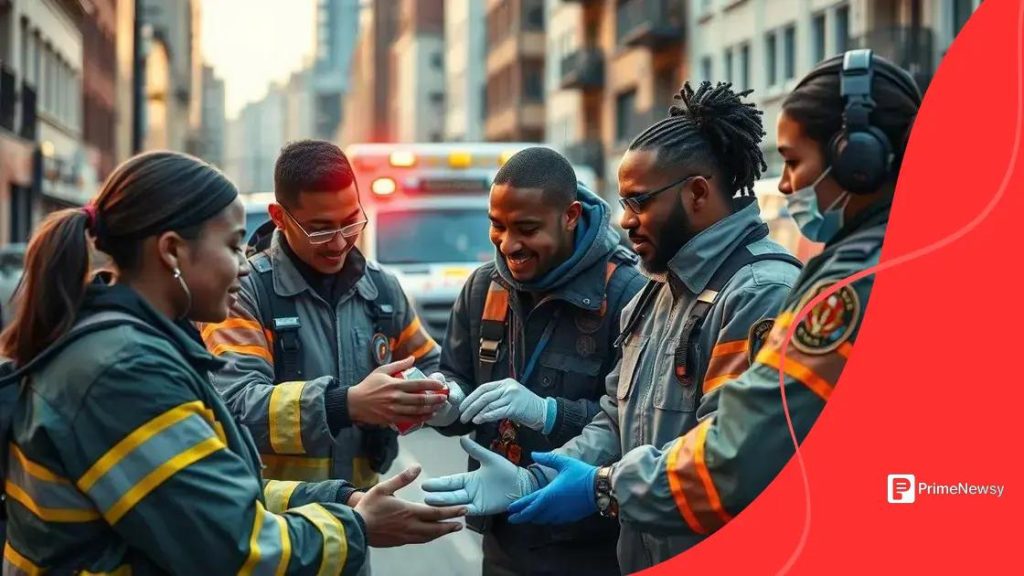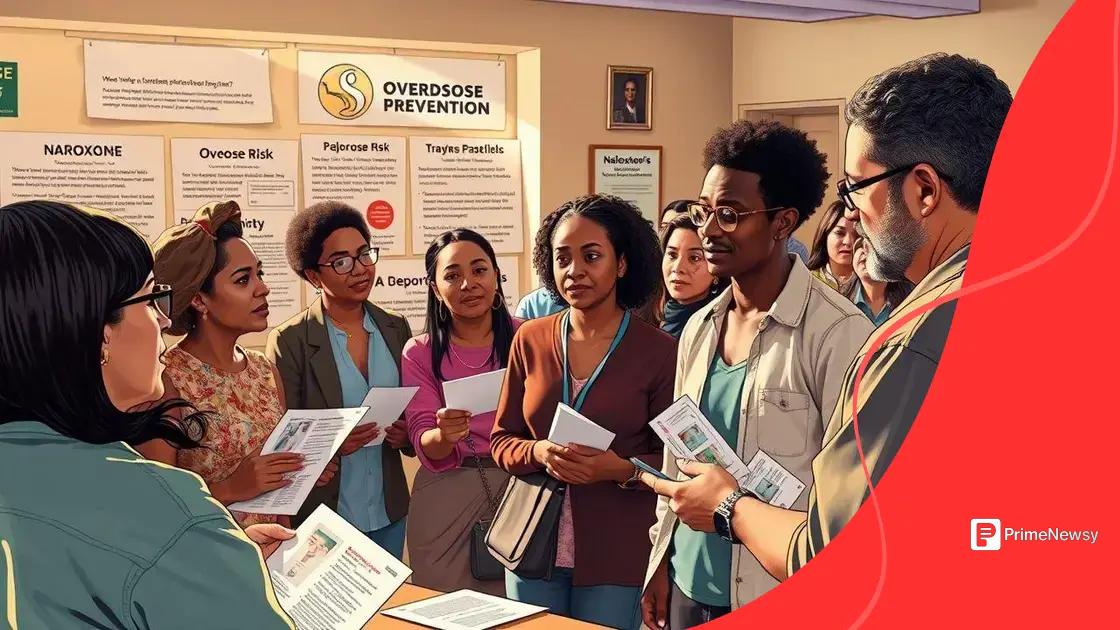Overdose crisis response: What you need to know

Anúncios
The overdose crisis response involves educating communities, training first responders, and implementing preventive measures like naloxone access to effectively save lives and support individuals affected by substance use.
Overdose crisis response plays a pivotal role in addressing the alarming rise in substance abuse-related deaths. But have you ever wondered how communities can effectively tackle this growing issue? Let’s dive into some strategies and insights that truly matter.
Anúncios
Understanding the overdose crisis
Understanding the overdose crisis is essential for anyone looking to grasp the full magnitude of this pressing issue. It affects not just individuals but entire communities, stretching resources and prompting urgent action.
Defining the overdose crisis
The overdose crisis refers to the alarming rise in fatalities resulting from drug overdoses, particularly those involving opioids. Records show a consistent increase in overdose deaths over the past decade, making it a public health emergency.
Key statistics
Awareness starts with understanding the numbers:
Anúncios
- Over 100,000 overdose deaths were reported in the last year.
- Opioids are involved in nearly 70% of these fatalities.
- Young adults, especially those aged 18-34, are most impacted.
Notably, these figures highlight the urgency of addressing this crisis. It’s crucial to recognize that the overdose crisis isn’t just a health issue—it’s a social one that requires community engagement and comprehensive strategies.
With multiple factors at play, including mental health, socioeconomic status, and access to healthcare, addressing the overdose crisis requires a multifaceted approach. Education and awareness are pivotal in breaking the stigma surrounding substance abuse. Many individuals struggling with addiction often face judgment rather than support.
The role of prevention
Effective prevention methods are vital. Communities can implement safe prescribing practices and provide resources for mental health treatment. At the same time, educating families on recognizing signs of an overdose can save lives.
- Community outreach programs are essential.
- Training for first responders on overdose recognition and response.
- Policy changes to expand access to treatment options.
By fostering discussions around addiction and creating safe spaces for individuals affected, we can challenge the stigma and encourage recovery paths that are not just accessible but also supported.
Key statistics and trends
Key statistics and trends about the overdose crisis paint a vivid picture of its impact on society. Understanding these numbers helps communities take action and shape effective responses.
Overdose death rates
Over the past several years, the rates of overdose deaths have soared dramatically. In fact, reports indicate that more than 100,000 lives were lost to overdoses last year alone. The issue has become urgent, drawing attention from health officials and policymakers alike.
Substance use patterns
Among the substances involved, opioids have a predominant role. Opioids are linked to roughly 70% of overdose fatalities. This troubling trend shows not only the prevalence of prescription drugs but also the rise of synthetic opioids, such as fentanyl, which are far more potent.
- Opioid overdoses have increased by over 300% since 1999.
- Fentanyl is involved in 60% of opioid overdoses.
- Stimulant overdoses, including methamphetamine, are also rising.
These statistics highlight the urgent need for comprehensive solutions that address both prevention and treatment. Additionally, it’s essential to consider demographics; young adults, particularly those aged 18-34, represent a significant portion of overdose deaths.
This age group faces unique pressures and challenges, contributing to the crisis. Targeted outreach and resources can make a significant difference. Families and communities can be part of the solution by educating themselves and each other.
Geographic trends
Geographically, the overdose crisis varies widely. Some regions have been hit harder than others, particularly rural areas where access to treatment is limited. Cities experience higher numbers due to concentrated drug trafficking patterns.
- The Midwest and Northeast report the highest overdose death rates.
- Rural areas struggle with fewer resources and higher stigma.
- Urban centers face challenges related to gang violence and drug trafficking.
By monitoring these trends, communities can better allocate resources and tailor interventions that address specific local needs. It also underscores the importance of collaboration among health providers, law enforcement, and community organizations in combating this crisis.
Community response initiatives

Community response initiatives are crucial in addressing the overdose crisis. Local efforts can make a significant difference in saving lives and providing support for those struggling with addiction.
Awareness programs
One of the first steps in any community initiative is raising awareness. This can involve educational programs aimed at informing citizens about the dangers of substance abuse. Workshops can teach valuable skills such as recognizing the signs of an overdose and understanding how to respond effectively.
Support services
Providing support services is essential for those affected. Many communities have started offering:
- Hotlines for immediate assistance.
- Access to counseling and mental health resources.
- Support groups for individuals and families.
These services create a network of support that encourages recovery and reduces stigma.
In addition to education and support, many communities have developed harm reduction strategies. These initiatives aim to minimize the negative effects associated with drug use without necessarily requiring abstinence. Programs like syringe exchange and supervised consumption sites have been adopted in various areas to reduce health risks.
Emergency response training
Training community members in emergency response can significantly impact survival rates during overdoses. Many local organizations offer training sessions on:
- Administering naloxone, a medication that reverses opioid overdoses.
- Basic first aid and CPR.
- Communication skills for effectively assisting individuals in crisis.
These programs empower individuals to act quickly in emergencies and help save lives. When communities come together, they can create a supportive environment that encourages those struggling with addiction to seek help.
Moreover, collaborations between local law enforcement, health care providers, and community organizations can enhance the effectiveness of these initiatives. By sharing resources and knowledge, these groups can implement comprehensive plans that address the overdose crisis more effectively.
Role of first responders
The role of first responders in the overdose crisis is vital. These professionals are often the first to arrive at the scene and can be crucial in saving lives.
Immediate response
When an overdose occurs, time is of the essence. First responders, including paramedics and emergency medical technicians (EMTs), are trained to quickly assess the situation. They identify the symptoms of an overdose, such as unconsciousness, slow or stopped breathing, and pinpoint pupils.
Administering treatment
First responders are equipped to administer naloxone, a life-saving medication that can reverse opioid overdoses. This medication can be given through:
- Nasal spray
- Intramuscular injection
- Subcutaneous injection
Rapid administration of naloxone can restore normal breathing and consciousness, buying precious time for further medical intervention.
In addition to administering naloxone, first responders provide supportive care, like monitoring vital signs and ensuring the safety of the individual until further assistance arrives. Their calm and decisive actions can significantly impact the individual’s chance of survival.
Community education
First responders also play a key role in community education. They are often involved in outreach programs to teach community members how to respond in an emergency. Providing information about:
- Recognizing signs of overdose
- How to use naloxone
- Connecting individuals to local resources
These initiatives help raise awareness about the overdose crisis and empower community members to act swiftly in emergencies.
Furthermore, first responders work closely with other community services, including addiction treatment facilities and mental health resources. This collaboration allows for a more comprehensive approach to addressing the overdose crisis.
Preventive measures and education
Preventive measures and education play a crucial role in tackling the overdose crisis. By informing communities and providing resources, we can reduce the risks associated with substance use and save lives.
Awareness campaigns
Awareness campaigns are designed to inform the public about the dangers of drug abuse. These campaigns often use social media, community events, and educational materials to reach diverse audiences. They focus on:
- Identifying signs of addiction and overdose.
- Explaining the effects of different drugs.
- Promoting safe practices in drug use.
Effective messaging can help individuals make informed choices and seek help when needed.
Education programs
Education programs in schools and community centers are vital for early intervention. These programs teach youth about the risks of drug use and coping strategies. They cover topics such as:
- Making healthy decisions.
- Understanding peer pressure.
- Accessing support services.
By equipping young people with knowledge, we can reduce the likelihood of future substance abuse.
In addition to education for individuals, training for families and caregivers is essential. Workshops can help families recognize signs of drug use and understand how to support loved ones in recovery. These resources create a safety net that enhances community resilience against the overdose crisis.
Access to resources
Providing easy access to treatment and recovery resources is another key preventive measure. Communities should ensure that information about:
- Local rehabilitation and counseling services.
- Hotlines for immediate help.
- Support groups for individuals and families.
is readily available. Outreach efforts can help bridge the gap between those in need and the services available to them.
FAQ – Frequently Asked Questions about Overdose Crisis Response
What are the key signs of an overdose?
Common signs of an overdose include unconsciousness, slow or stopped breathing, and pinpoint pupils. Recognizing these signs quickly is crucial for effective response.
How can naloxone help during an overdose?
Naloxone is a medication that can reverse the effects of an opioid overdose, restoring normal breathing and consciousness when administered promptly.
Why are community response initiatives important?
Community initiatives help raise awareness, provide resources, and create a supportive environment for individuals struggling with substance use issues.
What role do first responders play in overdose situations?
First responders are trained to quickly assess overdose situations, administer naloxone, and provide vital support until further medical assistance arrives.